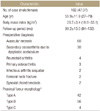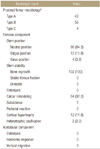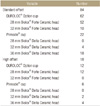Abstract
Purpose
The purpose of current study is to evaluate the midterm results of cementless primary total hip arthroplasty (THA) using a dual offset titanium tapered stem.
Materials and Methods
A retrospective analysis of 102 cases (84 patients), with a minimum of 7-year clinical follow-up, was performed. All of the cases consisted of patients who underwent primary cementless THA, using a dual offset titanium tapered stem in The Catholic University of Korea, Bucheon St. Mary's Hospital between July 2004 and May 2009. Clinical results were analyzed via the Harris hip score, level of thigh pain, squeaking around hip joint, and complication rate. Radiologic results were examined with stability and location of inserted prosthesis, hypertrophy of femoral cortex, and osteolysis.
Results
Out of the 102 cases (84 patients; 47 males and 37 females), with the mean age of 55.9 years (range, 27–79 years) and mean follow-up period of 99.2 months (range, 84–132 months). The mean Harris hip score was 53.8 preoperatively (range, 26–75) and improved to 93.5 postoperatively (range, 74–100) (p=0.000). All of the cases gained stable bony fixation on the final follow-up, including 2 cases of intra-operative proximal femur fracture. Calcar remodeling was observed in 94 cases, however, they were irrelevant with stem stability. Cortical hypertrophy of femur was seen in 12 cases and thigh pain in 4 cases; nonetheless, they were not relevant (p=0.067). There was 1 case of squeaking sound during joint movement. Hip dislocation occurred in 1 case early after the procedure, but the event was due to excessive anteversion of the acetabular cup, in which a revisional replacement procedure of the acetabular cup was conducted. No sign of ceramic breakage was observed. There were 2 cases of heterotrophic ossification.
Figures and Tables
Figure 1
Heterotrophic ossification occurred during the follow-up period after intraoperative periprosthetic fracture from a total hip replacement arthroplasty procedure with proximal femoral stem. (A) Neglected intraoperative periprosthetic fracture (Vancouver type A3) was observed (white arrowheads) on the radiograph taken 1 day after the surgical operation. (B) Circlage wiring fixation was performed 3 days after the surgery. (C) Femoral stem looks stable yet with heterotrophic ossification (black arrowhead) of Brook classification21) grade 2, 12 years after the surgery.

Figure 2
Anterior hip dislocation occurred 3 days after the surgery. (A) Radiograph taken immediately after the surgery was observed with 50 degrees of the inclinication angle and 42 degrees of the acetabular cup anteversion. (B) Anterior hip dislocation was seen 1 day after the surgery. (C) Revisional replacement of acetabular cup was done 3 days after the primary procedures, and the inclination angle was decreased to 40 degrees and the anteversion angle was decreased to 25 degrees.

Figure 3
Example of stable bony fixation. (A) Simple anteroposterior and lateral radiographs of the hip joint. (B) Anteroposterior and lateral radiographs of the hip joint taken 10 years after the surgery; calcar remodeling (white arrowhead) was observed.

Figure 4
Cortical hypertrophy around the stem proximal area. (A) Simple anteroposterior and lateral radiographs of the hip joint taken immediately after the surgery. (B) Anteroposterior and lateral radiographs of the hip joint taken 9 years after the surgery; Zones 5 and 10 were classified by Gruen et al.17) showed cortical hypertrophy (white arrowheads).

Figure 5
Kaplan-Meier survivorship curve with accompanying 95% confidence intervals for the endpoint of survivorship for any revision or additional fixation during primary surgery.

Table 1
Demographic Characteristics of Enrolled Patients

Values are presented as number only or mean±standard deviation (range). *Classification according to the Dorr et al.14)
Table 4
Radiologic Results of Enrolled Patients

Values are presented as number only or number (%). *Classification according to the Dorr et al.14)
References
1. Callaghan JJ, Dysart SH, Savory CG. The uncemented porous- coated anatomic total hip prosthesis. Two-year results of a prospective consecutive series. J Bone Joint Surg Am. 1988; 70:337–346.
2. Brinker MR, Rosenberg AG, Kull L, Galante JO. Primary total hip arthroplasty using noncemented porous-coated femoral components in patients with osteonecrosis of the femoral head. J Arthroplasty. 1994; 9:457–468.

3. Engh CA, Bobyn JD. The influence of stem size and extent of porous coating on femoral bone resorption after primary cementless hip arthroplasty. Clin Orthop Relat Res. 1988; (231):7–28.

4. Khanuja HS, Vakil JJ, Goddard MS, Mont MA. Cementless femoral fixation in total hip arthroplasty. J Bone Joint Surg Am. 2011; 93:500–509.

5. Kim YH, Kim VE. Cementless porous-coated anatomic medullary locking total hip prostheses. J Arthroplasty. 1994; 9:243–252.

6. Cinotti G, Della Rocca A, Sessa P, Ripani FR, Giannicola G. Thigh pain, subsidence and survival using a short cementless femoral stem with pure metaphyseal fixation at minimum 9-year follow-up. Orthop Traumatol Surg Res. 2013; 99:30–36.

7. Dalury DF, Gonzales RA, Adams MJ. Minimum 5-year results in 96 consecutive hips treated with a tapered titanium stem system. J Arthroplasty. 2010; 25:104–107.

8. Goetz DD, Reddy A, Callaghan JJ, Hennessy DW, Bedard NA, Liu SS. Four- to six-year follow-up of primary THA using contemporary titanium tapered stems. Orthopedics. 2013; 36:e1521–e1526.

9. Hwang BH, Lee WS, Park KK, Yang IH, Han CD. Straight tapered titanium stem with alumina bearing in cementless primary total hip arthroplasty: a minimum 5-year follow-up. J Arthroplasty. 2011; 26:1310–1317.
10. Yang IH, Park SH, Han CD. Cementless total hip arthroplasty using ceramic-on-ceramic summit(R) system: 3 years follow up. J Korean Hip Soc. 2007; 19:9–15.

11. Moed BR. The modified Gibson approach to the acetabulum. Oper Orthop Traumatol. 2014; 26:591–602.

12. Dolhain P, Tsigaras H, Bourne RB, Rorabeck CH, Mac Donald S, Mc Calden R. The effectiveness of dual offset stems in restoring offset during total hip replacement. Acta Orthop Belg. 2002; 68:490–499.
13. Harris WH. Traumatic arthritis of the hip after dislocation and acetabular fractures: treatment by mold arthroplasty. An end-result study using a new method of result evaluation. J Bone Joint Surg Am. 1969; 51:737–755.
14. Dorr LD, Faugere MC, Mackel AM, Gruen TA, Bognar B, Malluche HH. Structural and cellular assessment of bone quality of proximal femur. Bone. 1993; 14:231–242.

15. Martell JM, Pierson RH 3rd, Jacobs JJ, Rosenberg AG, Maley M, Galante JO. Primary total hip reconstruction with a titanium fiber-coated prosthesis inserted without cement. J Bone Joint Surg Am. 1993; 75:554–571.

16. Engh CA, Massin P, Suthers KE. Roentgenographic assessment of the biologic fixation of porous-surfaced femoral components. Clin Orthop Relat Res. 1990; (257):107–128.

17. Gruen TA, McNeice GM, Amstutz HC. “Modes of failure” of cemented stem-type femoral components: a radiographic analysis of loosening. Clin Orthop Relat Res. 1979; (141):17–27.
18. Maloney WJ, Jasty M, Harris WH, Galante JO, Callaghan JJ. Endosteal erosion in association with stable uncemented femoral components. J Bone Joint Surg Am. 1990; 72:1025–1034.

19. Joshi RP, Eftekhar NS, McMahon DJ, Nercessian OA. Osteolysis after Charnley primary low-friction arthroplasty. A comparison of two matched paired groups. J Bone Joint Surg Br. 1998; 80:585–590.
20. DeLee JG, Charnley J. Radiological demarcation of cemented sockets in total hip replacement. Clin Orthop Relat Res. 1976; (121):20–32.

21. Brooker AF, Bowerman JW, Robinson RA, Riley LH Jr. Ectopic ossification following total hip replacement. Incidence and a method of classification. J Bone Joint Surg Am. 1973; 55:1629–1632.
22. Kröger H, Venesmaa P, Jurvelin J, Miettinen H, Suomalainen O, Alhava E. Bone density at the proximal femur after total hip arthroplasty. Clin Orthop Relat Res. 1998; (352):66–74.
23. Karachalios T, Tsatsaronis C, Efraimis G, Papadelis P, Lyritis G, Diakoumopoulos G. The long-term clinical relevance of calcar atrophy caused by stress shielding in total hip arthroplasty: a 10-year, prospective, randomized study. J Arthroplasty. 2004; 19:469–475.
24. Lavernia C, D'Apuzzo M, Hernandez V, Lee D. Thigh pain in primary total hip arthroplasty: the effects of elastic moduli. J Arthroplasty. 2004; 19:10–16.
25. Herzwurm PJ, Simpson SL, Duffin S, Oswald SG, Ebert FR. Thigh pain and total hip arthroplasty: scintigraphy with 2.5-year followup. Clin Orthop Relat Res. 1997; (336):156–161.

26. Katsimihas M, Katsimihas G, Lee MB, Learmonth ID. Distal femoral cortical hypertrophy: predisposing factors and their effect on clinical outcome. Hip Int. 2006; 16:18–22.

27. Lee TH, Moon YW, Lim SJ, Park YS. Meta-analysis of the incidence and risk factors for squeaking after primary ceramic-on-ceramic total hip arthroplasty in Asian patients. Hip Pelvis. 2014; 26:92–98.

28. Petis S, Howard JL, Lanting BL, Vasarhelyi EM. Surgical approach in primary total hip arthroplasty: anatomy, technique and clinical outcomes. Can J Surg. 2015; 58:128–139.





 PDF
PDF ePub
ePub Citation
Citation Print
Print





 XML Download
XML Download